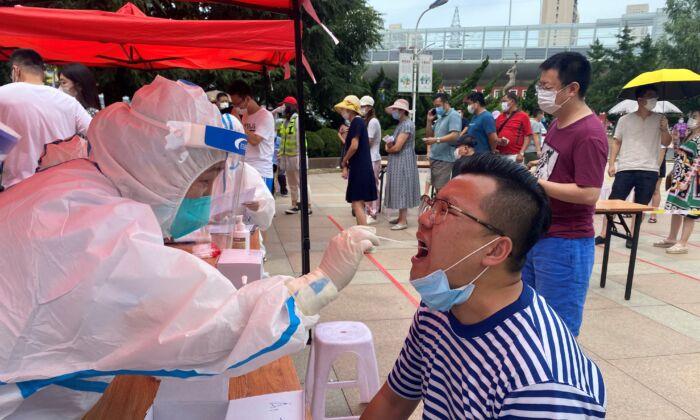The Epoch Times obtained leaked documents from local police departments in China that reveal the communist regime’s public security (Chinese police) continues to receive funding, despite a nationwide budget cut announced during the “Two Sessions”—an annual meeting of the Chinese Communist Party (CCP)’s rubber-stamp legislature and its advisory body to enact policies and agendas.
During a video-based press conference in Beijing on May 28, Chinese premier Li Keqiang said that “the central government will lead by example in living on a tight budget,” and “cut over 50 percent of outlays on non-essential, non-obligatory expenditures at the central government level.” In particular, he stressed, “governments at all levels must tighten their belts, and reject pointless formalities and spending splurges.”
Baoding City
Baoding has a population of over 11 million people and is located in central Hebei Province, approximately 93 miles southwest of the regime’s capital, Beijing.On Jan. 16, the Baoding municipal government set goals to tighten its budget and cut spending, according to its 2020 annual report. However, the internal documents obtained by The Epoch Times show a different plan.
Baoding city’s internal document dated on May 20 proposed a plan to improve the facilities of its police department and to implement artificial intelligence to ensure law enforcement operates efficiently.
Baoding’s proposal stated: “Optimize the infrastructure and the police force, and secure a long-term funding and facility support system.” This means money and personnel are guaranteed in order to “strengthen police work in the new age.”
A committee was formed to execute the plan. The group included the deputy mayor of Baoding, and the heads of the local public security bureau, the civil affairs bureau, the housing construction bureau, the finance bureau, and the development and reform commission.
To optimize the infrastructure and police force, the document stated that there should be enough staff and accommodation in the police stations.
In order to secure long-term funding to support the police facilities, the municipal finance bureau and other departments should fully guarantee the funds, with a priority to fully equip the police force with vehicles, mobile terminals, and video cameras, according to the document.
Both the city and county governments are required to secure a budget for wages, welfare, and equipment acquired by the police force assistants (part-time workers at the police station).
The document specifically emphasized “the authority” of law enforcement, in particular, the press release of social events and opinions involving the public security bureau must be forbidden and censored.
Chongqing City
Internal documents from Chongqing city, in southwest Sichuan Province reveal that the municipal government has cut their budget, except for its police department.The Jiulongpo district office issued a notice on March 3 on the “10 measures” for operating on a tight budget and to cut spending.
Another document also from Jiulongpo district on the same topic was issued on July 3 by the local human resources and social security bureau.
Local Hospital in Debt
While the police force in Jiulongpo continues to receive funding, the Second People’s Hospital in the district is on the verge of bankruptcy, according to internal documents obtained by The Epoch Times.According to the hospital’s financial report, its total debt to asset ratios were 84.5 percent in 2017, 87.8 percent in 2018, and 89.5 percent in 2019. The ratio is close to 100 percent, indicating that it is close to insolvency. However, the urgent crisis of the hospital was its short- and medium-term debts.
In the same document, the hospital’s total assets were 139.5 million yuan in 2017, 127.2 million yuan in 2018, and 137.3 million yuan in 2019. The total liabilities were listed as 117.8 million yuan in 2017, 111.7 million yuan in 2018, and 122.9 million yuan in 2019. Long-term liabilities accounted for less than 0.5 percent of the total debt, at 525,700 yuan in 2017, 400,000 yuan in 2018, and 400,000 yuan in 2019.
In other words, the proportion of short- and medium-term debt exceeds 99.5 percent every year. This means that more than 99.5 percent of the debt of the hospital needs to be repaid immediately or in the near future, but the hospital cannot afford to do so.
According to a 2017 report by China Hospital CEO, a biweekly magazine, the scale of public hospital debt in China has risen with a compound growth rate of 20.5 percent since 2005, “as of the end of 2014, the scale of public hospital debt has reached trillions of yuan.” According to the report, 90 percent of county-level hospitals are operating in debt. The high debt ratio not only increases the financial risk of public hospitals, but also prompts hospitals to increase fees and the cost of medicinal drugs to pay off the debts. Consequently, the ordinary people have to pay for expensive medical services.




